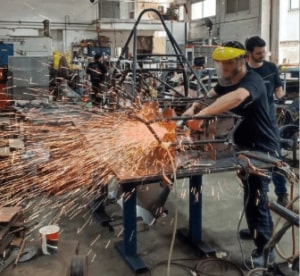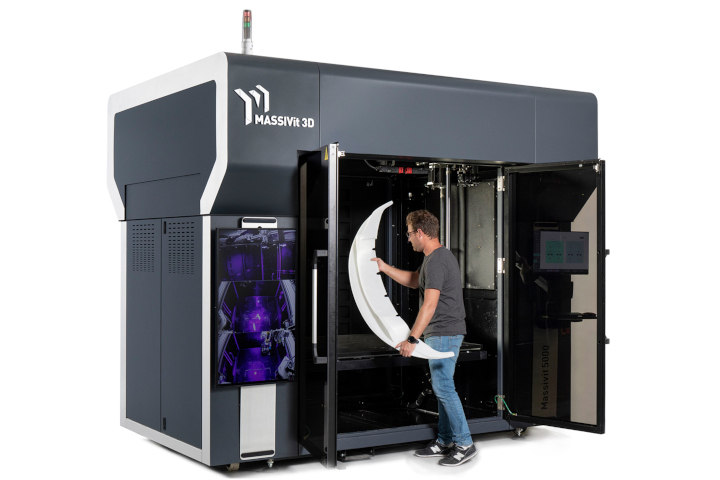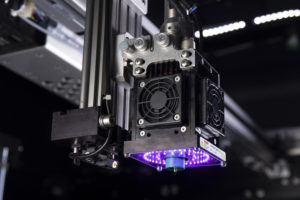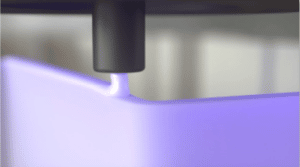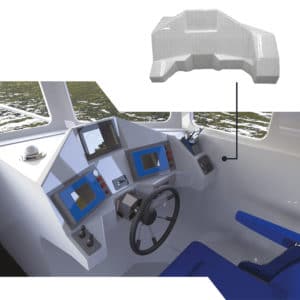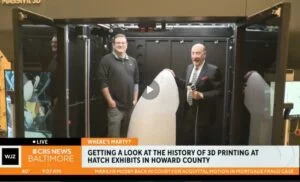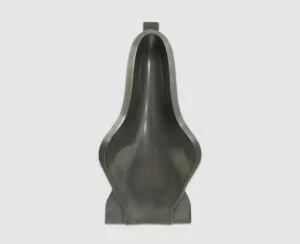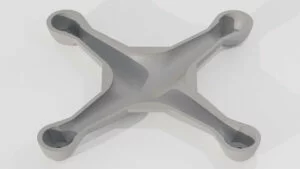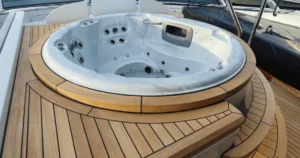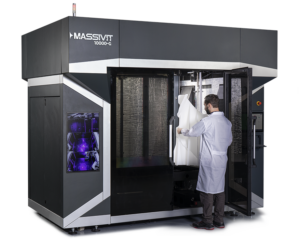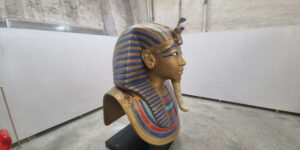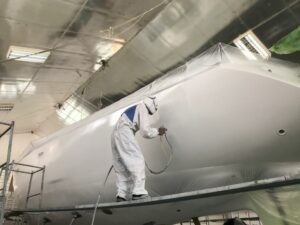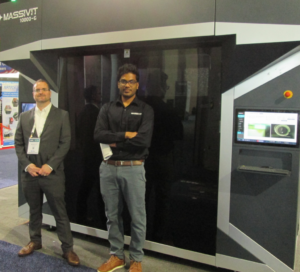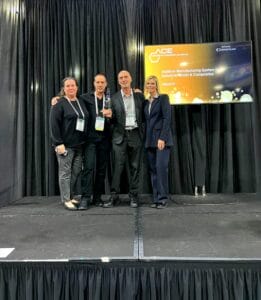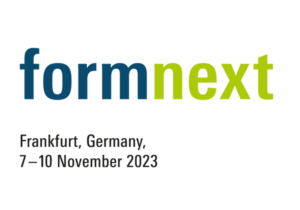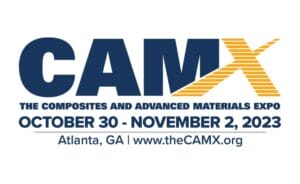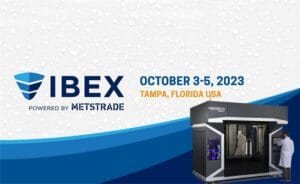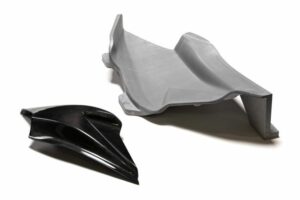One aspect of the manufacturing arena that is in dire need of an upgrade is the composite materials market; production processes for end-use parts made of fiberglass, carbon, and kevlar have somewhat stagnated in recent decades. Creating fiber-reinforced plastic (FRP) parts has always been a challenge, but now new technologies are revolutionizing this industry, kickstarting a new “tool-less” era for composite manufacturing.
[Top image: Formula car nose 3D printed in 16 hours on a Massivit 1800 by 3D Pro]
Formula Car Engineered by Mechanical Engineering Team at Ben Gurion University with 3D Printed Nose & Spoilers
3D-Printing FRP Parts
Composites fabricators across multiple industries spend valuable time and resources producing the plug and mold for a desired FRP part. Massivit– a global provider of large-scale 3D printers – has introduced a new process for ultra-fast manufacturing of lightweight and strong composites. The process is driven by the versatility of the company’s Gel Dispensing Printing (GDP) technology and its ability to print large, thin, complex structures at high speed – skipping the need for a mold and arriving directly at a complete part ready to be reinforced by hand lay-up or vacuum bagging.
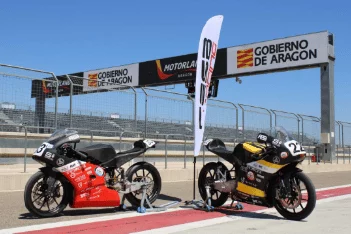
The Massivit 5000 offers a long-awaited solution to AM market gaps in printing size and speed, boasting an impressive build volume of 57” x 44” x 70”. Advanced photopolymer materials that cure instantly under UV light enable production speeds up to 30 times those of other 3D printers. Adopters of GDP technology have seen tangible benefits for the production of full-scale parts as well as composite components.
The Process
Massivit 5000 Large-Scale 3D Printer
Parts that are printed on the Massivit 5000 can serve as a geometric core for end-use FRP parts. By coating the printed core structure with a thin layer of composite material using a hand lay-up process, a composite part is formed with high strength and stiffness of a fiber-reinforced polymer – but at a low weight. This coating can also be done using vacuum bag molding, which uses a flexible film made of a material such as nylon polyethylene or polyvinyl alcohol (PVA) to enclose and seal the part from the outside air.Many times, the vacuum bag molding technique is performed with the assistance of the hand lay-up technique. Laminate is first made by using the hand lay-up technique, then placed between the vacuum bag and the mold to ensure fair infusion of fibers into the matrix material. The air between the mold and the vacuum bag is then drawn out by a vacuum pump while atmospheric pressure compresses the part.Laying the composite directly on the printed part eliminates the need for a mold altogether, as the final form and geometry are digitally fabricated according to the desired CAD design. This has immense advantages over traditional composite manufacturing processes that require extensive setup times – and budgets – to first produce molds and tools.
Cutting-Edge Polymer Materials
Gel-Based Dimengel Enables High-Speed 3D Printing for Composite parts
The high tooling costs associated with large composite and plastic parts for short-to-medium runs make up a significant part of the overall component costs. GDP offers a far more efficient way to achieve this, utilizing a range of specialized thermoset photo polymer materials that enable large core parts to be produced within a matter of hours, instead of days or weeks. Unlike other AM technologies, GDP enables printing with hardly any need for support structures, reducing material waste and making post-processing minimal and fast.
Printing Head on Massivit 5000 with UV Ring for Curing On-The-Fly.
Massivit’s family of Dimengel printing materials offers a variety of physical properties to suit any number of potential applications. For situations in which flame retardancy is necessary – such as certain transportation and architectural applications – flame retardant resins can be coupled with Massivit 3D’s UL94-V0 compliant Dimengel 20-FR printing material, a recently launched 3D printing material developed to serve essential flammability-related safety and performance requirements.
3D-Printing Spare Parts on Demand Too!
Tool-less composite manufacturing is just one of many innovative applications facilitated by Massivit’s large-scale AM systems and patented Dimengel photopolymer printing materials, technologies that are being leveraged for the fast production of end-use parts throughout industries such as rail, marine, automotive, scenic fabrication, and architecture.
Perfect for the Railway Industry
Railway manufacturers frequently require specialized and obscure spare parts on demand for a wide range of train and tram models. Conventional rail manufacturing processes require a minimum of three months just to produce a mold for a composite end-use part. This requires rail operators to maintain a large inventory of different types of spare parts at multiple locations, an expensive and overall inefficient business model.
Stratiforme Industries – a renowned service bureau that serves leading rail manufacturers including Alstom, SNCF, and Thalys – adopted a Massivit 3D 5000 to speed up their lead times by directly printing large parts and then reinforcing them with composite materials, ready for the tracks. The company 3D printed and reinforced the front-end FRP central cabin panels for a light rail vehicle without the need to first produce a mold.
The Massivit 5000 allows Stratiforme Industries to produce large, custom spare parts in significantly less time compared with conventional methods. The technology also reduces the need to stock an unwieldy inventory of spare parts in multiple locations, further decreasing operating costs and waste.
Leveraged by the Marine Industry
Custom Dashboard for Yacht 3D Printed by Velum Nautica
The marine industry is another sector that has long awaited a high-speed solution for manufacturing large-scale, lightweight, composite parts that can withstand harsh environmental conditions. Producing custom parts for nautical vessels by traditional methods requires multiple skilled craftsmen working for weeks or months to create a single mold from which a part can then be cast.
One company already leveraging this technology is Velum Nautica, a leading company in the field of vessel customization, maintenance, and repair. Bože Radan, their lead design engineer, is thrilled with how their production process has changed. He explained that, “One of our customers spent a year looking for a part without luck. With our Massivit printer, we simply print parts on-site for them within a few hours that would usually take two team members a few days to produce.” Velum Nautica now uses their Massivit printer to produce custom radar masts, dashboards, stern extensions, and interior fixtures.
The speed of Massivit’s patented GDP technology allows clients to keep their vessels out at sea instead of stuck on the docks. Velum Nautica’s team is able to create complex geometrical features suited to any customer’s needs. In addition, the ability to print full-scale parts in one piece enables nautical manufacturers to consolidate a vessel’s total part count, achieve a 100% hermetic seal against water, and improve the tolerance of parts.
The Future is Here
Large-scale additive manufacturing combined with composite materials present a match made in heaven for manufacturers. The recognized advantages of digital fabrication combined with the strength and stiffness afforded by composite materials provide the backbone for a true revolution in manufacturing at large.
Along with FRP parts made by printing on the Massivit 5000, the addition of the award-winning Massivit 10000 shakes up the industry even further. The 10000 is designed to automate tooling for composite manufacturing, shortening the traditional 19-step workflow down to just four steps. Its Cast-In-Motion technology combines GDP with direct casting, enabling composites fabricators to digitally produce true isotropic molds.
Whether casting a composite part directly into a 3D-printed shell, or reinforcing a 3D-printed part to create an FRP part, Massivit is changing the way we look at additive manufacturing for composites.



